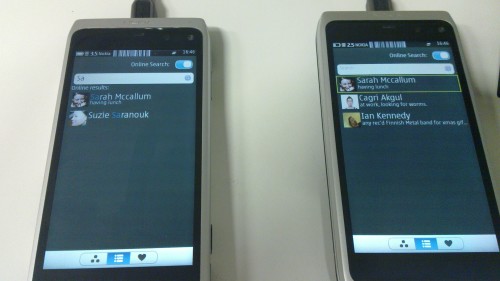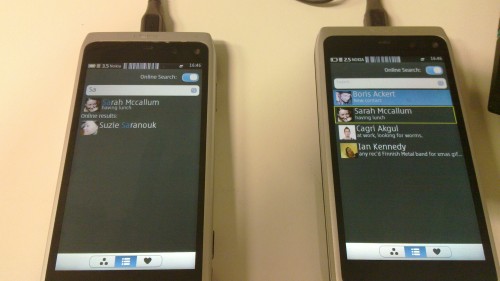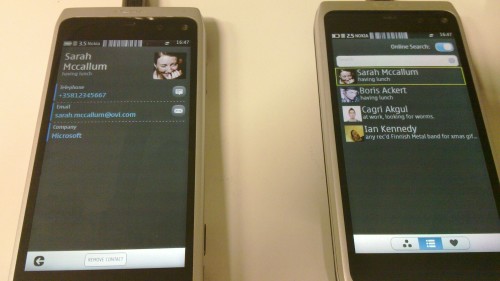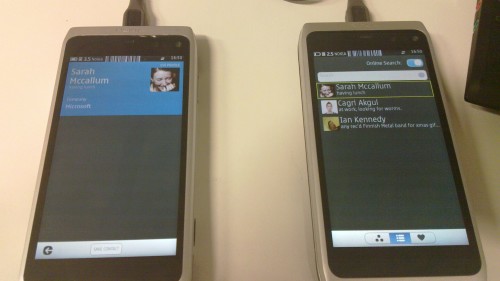Joseph Smarr’s blog post, Turns out we still need Plaxo (or something like it) had me digging through my archives for some screenshots taken from an old prototype I worked on a few years back. The concept was simple and combined the double opt-in privacy features you get from Facebook with the simplicity of a phone address book.
The story starts with two phones, Boris’ on the left and Sarah’s on the right. The owner of the phone has a public card they can edit (outlined in yellow). By tapping on it, they can add whatever information they feel comfortable sharing to the public. Updating this info on your phone copies it up to the public directory. On it you see a photo, name, and latest status.

Boris decides he wants to search for Sarah. He begins to type and the list of matching entries narrows until Sarah’s entry is highlighted.

Tapping on Sarah’s entry, Boris can view Sarah’s public card. This info is stored on a server, tied to her phone number. Think of it as the white pages in the cloud, like a DNS record for people, matching IP addresses to domain names.

Boris has the option to save the public contact record to his local phone book. This action sends a notification to Sarah (it says “New Contact” below Boris’ name as a status) that Boris has saved her public card to his phone book. It’s like a Facebook friend request but more functional.

Tapping on Boris’ name in the list view, Sarah can pull up Boris’ contact card. Because Boris has already saved Sarah’s card to his phone, Sarah has the rights to view Boris’ full contact card with additional information such as his phone number and email address. Sarah has the option to Accept or Decline Boris’ connection request.

Sarah accepts Boris’ connection request so now Boris has access to Sarah’s full contact card and “unlocks” additional information on Sarah’s profile such as her phone number and email address.

Now that both Sarah and Boris have saved the other’s contact card to their phone, they unlock private information that is only available to their connections. The act of saving a contact card can be either via the look-up method above or even by calling someone and that person saving the phone number from their call log to their address book.

Later, if Sarah wants to “pull back” her contact details from Boris’ phone, all she has to do is delete Boris’ contact card from her address book. Once she does so, her contact card on Boris’ phone reverts back to its public profile.

There are many versions of this type of system. As Joseph mentioned, Facebook offers this if you look at the About section on anyone’s profile. Google+ also allows you to manage access to private information based on which circle you save someone to. Even Plaxo had the concept of Work & Home card and you could chose who had access to what.
My point is that no one manages their personal contact details as part of a social network. The only way you’re going to get people to keep their data current is if their card is in front of them every day as part of their daily interaction with people.
Every time you call or text someone using the system above, you’re going to leave a link to your public calling card on their phone. As people interact with your card, they are going to be unlocking additional details that will help build their connection with you. Let’s say your work address or busy/free space on your calendar is part of that additional information that gets unlocked. You’re going to want to keep this information accurate.
There are all sorts of holes you can poke into such a system. For example, I can write my profile to look like some celebrity and save a bunch of people to my phone book and hope to dupe someone into counter-saving my profile to their phone and thus revealing their private information. To counter this, maybe you need to verify people’s names with a text message with a link or code that ties their name to their phone number.
Also, once someone unlocks your profile, there is no real way to take it back as they can take a screenshot and save that info as a photo.
Yes, there are holes but as a start what do you think. Is it intuitive? Does it make sense? The concept of your phone number as the equivalent of an IP address tied to a directory that contains further details is attractive. If we can get over the fact that a phone number isn’t really private and should be used as one-half of a key opens up many possibilities.
I’d love to hear your thoughts.
Leave a comment